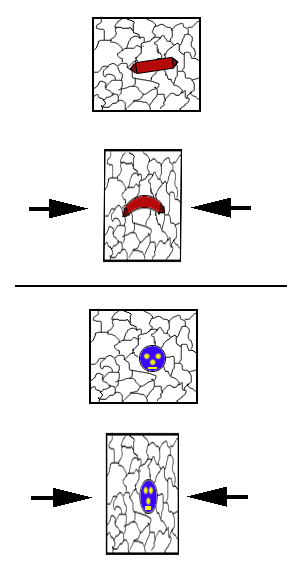| THE HYPOTHESIS: In places, the crust of the earth is subject to horizontal forces that cause deformation. These deformational forces may cause the surface of the earth to be locally uplifted, depressed or tilted. Local uplifts may result in hills or mountains. Local depressions may result in lowlands or valleys. Tilting may cause previously flat areas to become inclined. One or more major landforms of the NYC area are due to uplift, depression or tilting caused by deformation.
THE PREDICTION: In this exercise, it will be your job to devise a prediction (other than the example provided below) that will be a strong test of the hypothesis. One way to devise a prediction is to ask a series of 'suppose-then' questions. Consider the following 'suppose-then' dialog: Suppose the earth's crust was subjected to horizontal compression that created deformational forces, then:
EXAMPLE: Consider the first 'suppose-then' question: 'Suppose the earth's crust was subjected to horizontal compression that created deformational forces, then what changes would take place in the material out of which it is composed?' Your answer might be "Rock layers would be folded." (Note that 'folded' includes 'arched' and 'tilted'; see examples to right.) That answer may then be turned into a prediction: SAMPLE PREDICTION: One or more major landforms of the NYC area will be composed of folded rock layers.
Now you know that you need to collect data about
To collect the needed data about (1) horizontal compression and (2) the character of NYC rocks, click on the blue button.
If a review of the process of horizontal compression reveals that it causes deformation that results in folded rock layers, and an examination of the rocks of the NYC region reveals places where rock layers are folded, then the prediction is fulfilled and it appears that the hypothesis that those landforms were produced by deformation is supported. END OF EXAMPLE
WEAK VS. STRONG TESTS The test of the hypothesis that 'One or more major NYC landforms are the result of deformation' that was used in the 'example' was not very strong. In the example it was established that
What is needed, therefore, is to:
The more demanding the test, the more strongly the hypothesis will be supported if the test is passed. Click on the grey button to open a separate window and gather information about possible relationships between folded rock layers and landforms.
 Consult the 'deformation rollover' and answer this question: For an area of hills and valleys or for a sloping flat surface underlain by folded rock layers, how may one tell if the landforms are the direct result of the deformational forces that folded the layers? Consult the 'deformation rollover' and answer this question: For an area of hills and valleys or for a sloping flat surface underlain by folded rock layers, how may one tell if the landforms are the direct result of the deformational forces that folded the layers?HINT: Pay special attention to the bottom two rows of 'rollover buttons'.
 Consult the 'deformation rollover' and answer this question: For an area of hills and valleys or for a sloping flat surface underlain by folded rock layers, how may one tell if the landforms are NOT the direct result of the deformational forces that folded the layers? Consult the 'deformation rollover' and answer this question: For an area of hills and valleys or for a sloping flat surface underlain by folded rock layers, how may one tell if the landforms are NOT the direct result of the deformational forces that folded the layers?HINT: Pay special attention to the bottom two rows of 'rollover buttons'.
MY PREDICTION: ANOTHER POSSIBILITY: Earlier on, in response to the query as to what changes would take place in the material of the Earth's crust when it was deformed, the response that "rock layers would be folded" seemed a reasonable and productive answer (productive in the sense that it suggested a useful prediction that could be used to test the hypothesis). However, not all earth materials are layered. In consequence, tests of the 'deformation hypothesis' that involve the prediction that folded layers will be found will not be helpful for those places where unlayered materials directly underlie the surface of the earth. If there are no layers, then such tests provide no evidence and are irrelevant. The implications of the failure to find folded rock layers will be 'unclear'. Detection of deformation of unlayered materials (and the formation through deformation of landforms made out of them) must be sought in some other fashion.
MY PREDICTION: |  

|
